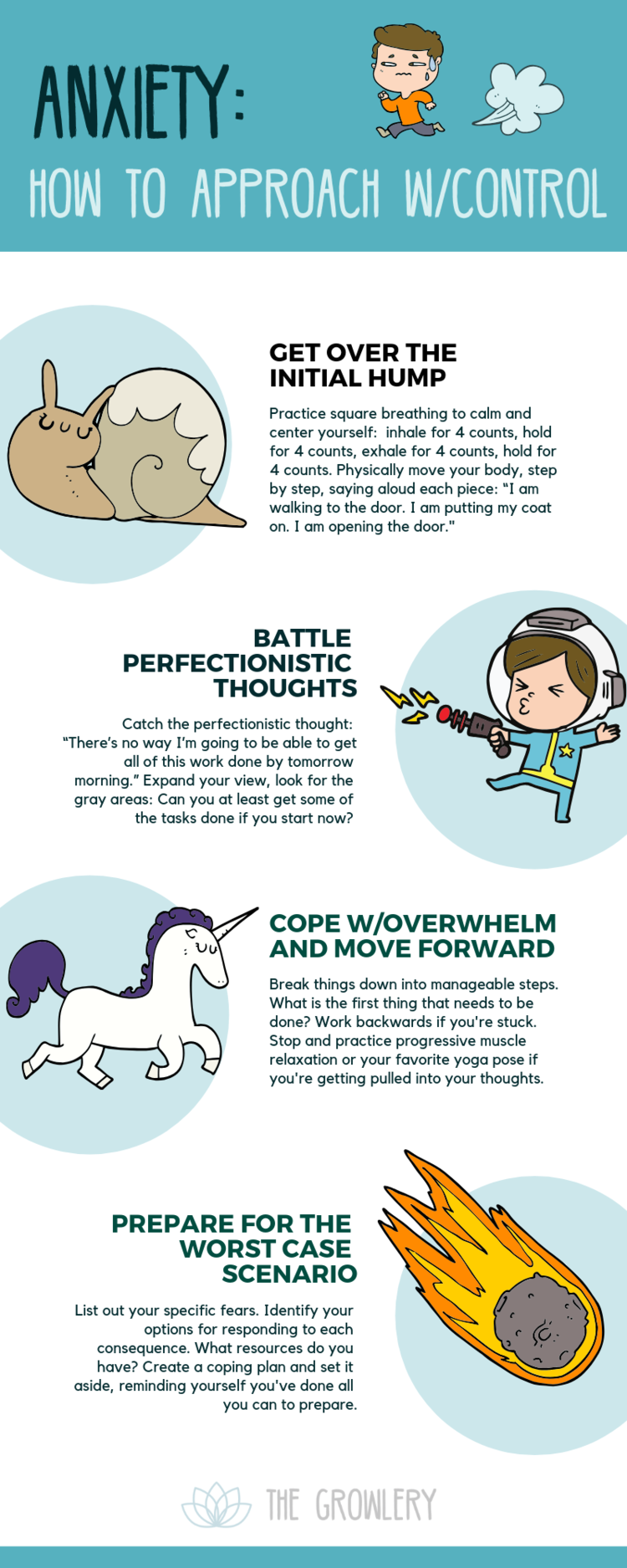Learning to Live With Anxiety - Part Three: How to Approach With Control
When you choose to approach:
Confront your anxiety without letting it consume you
You’ve decided that this is a situation where avoiding your anxiety is going to make things work. You need to tackle the problem in front of you and face it head on, but how do you do this while managing the overwhelming panic, worst case scenarios, and urge to crawl under the blankets and hide?
It’s going to take a lot of mental and emotional effort to approach your anxiety, but it can be done. Let’s walk through some options together.
SCENARIO 1:
YOU JUST NEED TO GET OVER THE INITIAL ANXIETY OF TAKING THE FIRST STEP.
Practice square breathing to calm and center yourself—find a square or rectangular object in the room, and inhale for 4 counts while you trace the length of one side with your eyes; then hold your breath for another 4 counts as you move from one corner to the next. Repeat, exhaling for 4 counts and holding your breath for 4 counts until you’ve completed the rectangle. Then work on physically moving your body, step by step, saying aloud each piece: “I am opening up my computer. I am signing into my e-mail. I am opening a new message and typing my boss’ name into the send: field.”
SCENARIO 2:
YOU’RE READY TO GET STARTED, BUT THE FIRST STEP ISN’T OBVIOUS AND YOU FEEL OVERWHELMED.
If you can, use your therapist or a close friend for help in breaking things down into more manageable steps or pieces. What is the immediate, first thing that needs to be done in this situation, before anything else can happen? You can also work backwards if that’s helpful—start out thinking about how you want the end result to be, and identify each step that must come just before the next in order for things to turn out the way you want. Stop and engage in some brief physical movement—scrunch your shoulders up towards your ears and release, do your favorite yoga pose, stand up and hang your head and arms in a forward fold—relaxing your body will help relax your mind, too.
SCENARIO 3:
PERFECTIONISTIC THOUGHTS ARE GETTING IN THE WAY OF MAKING A PLAN OR TAKING THE FIRST STEP.
First, identify the exact thought getting in the way: “I’m making the wrong decision.” “There’s no way I’m going to be able to get all of this work done by tomorrow morning.” Once you’ve identified the thought, see if you can expand your view to incorporate any data that falls even a little bit outside of your thought, if not challenge it entirely. Is there actually a “right” or “wrong” decision? Is it actually that your decision is uncomfortable and unpleasant? Can you at least get some of the tasks done if you start now, even if not all of it will be complete? Once you’ve moved out of black-and-white thinking and into the gray area, taking that first step won’t feel as hopeless or pointless.
SCENARIO 4:
YOU’RE NOT SURE THINGS WILL WORK OUT…AND THIS ISN’T A COGNITIVE DISTORTION.
While it’s true that sometimes anxiety leads you to exaggerate how bad things will really be, there are also times when your anxiety is 100% real and valid. If you’re going through a challenging time with your partner, there may honestly be a chance that things won’t work out in the end. You might mess up that really important interview for your dream job. That weird sound your car is making could end up being a $500 repair. If you’ve examined your thoughts and determined that your worries are truly justified, you need to approach slowly and with care. Again, this is helpful to do with a therapist or trusted friend, in case difficult emotions come up for you. Start by listing out the exact consequences you fear will happen—it may seem counterintuitive, but get as detailed and specific as you can. Then, identify your options for responding to each consequence. For each option, come up with at least 2 resources you have to help you if that’s the way you decide to go. Resources can be people in your life, skills and strengths that you possess, or tangible things. These steps are all about getting yourself into problem-solving mode and out of analysis paralysis. Once you’ve gathered all the data about possible outcomes and choices, create a plan for coping with the worst case scenario…and then set it aside and remind yourself you’ve prepared for the worst.
If you’re ready to get serious about approaching your anxiety, we’d love to help. Set up a free phone consult to talk more about your goals for therapy and how we can help.

